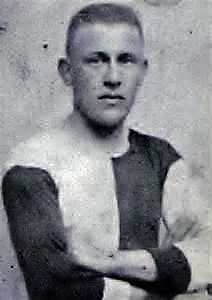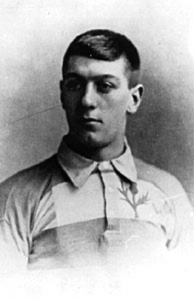CURIOUS FACTS ABOUT NATIONAL AND INTERNATIONAL PLAYERS (1907)
Picture : Robert De Veen with Belgium’s National Team.
Interesting and curious facts about full internationals and national players (1907)
————————————————————————————————————–by IFFHS—
1907
George Owen Williams, born in Wednesday (Birmingham) in September 1879, first played for King’s Hill School, Monway FC, Oldbury and Wednesbury Old Athletic before joining West Bromwich Albion in October 1900. From 1902 on he played for Brierley Hill Alliance, Kidderminster Harriers, Wrexham, Stafford Rangers, Willenhall Swifts and Walsall. He moved around a lot, but he also was a good centre-half. Even though he was born in England, he did not disclose this to the FA of Wales and played for Wales on February 23, 1907 (3:2 Ireland in Belfast). George Williams served with the King’s Royal Rifle Corps during World War I and was killed in France in 1916.
——
Left wing half-back George McClureof Cliftonville FC (Belfast) made his international début for Ireland in Belfast on February 23, 1907, which ended with a 2:3 loss to Wales. He was an Irishman who was born in Scotland, on July 26, 1885. Ireland’s goalkeeper on that match day was James John Sherryof Bohemians FAC (Dublin). The two times international died on January 26, 1914, at the age of 27. Also at this match, Irish outside right was John Blairof Cliftonville FC (Belfast), a winger born on November 12, 1882, who became president of the Irish League during the 1921/22 season.
——
In 1907 things had become quite unbearable for the Belgian national team, especially when it came to test matches. The Belgian selection had won a match against the Rheinisch-Westfälischer Spiel-Verband (2:0) in Cologne (Germany). The team travelled back on the same day, and the four players from Bruges (Brugge) – Arthur and Charles Cambier, Robert de Veen, Hector Goetinck – reached the Brussels railway station late in the evening, where they were left to themselves. Having first spent the trip on wooden seats on the train, they now spent the night on wooden benches at the railway station so as to get to Bruges the next day. Moreover, the national players were required to bring their used kit to the next match, or else to send it – washed – to the selection committee.
——
Thomas Alexander Jackson, born in Thornliebank (Renfrewshire) on November 12, 1878, first played for Summerlee Juveniles and Thornliebank FC before joining St. Mirren FC (Paisley) in 1898. He would stay with the club for 11 seasons. The right full-back, a gentlemanly player, always remained an amateur. From 1904 to 1906 he played for Scotland six times. He also was an excellent bowler and billiards player. A hat dealer by profession, he fell in 1916 while fighting in World War I.
——
When Scotland met England (1:1) at James’ Park in Newcastle-upon-Tyne on April 6, 1907, the Scottish national team included nine (!) legionnaires mercenaries who played professionally for English clubs. The only two players who were with Scottish clubs were full-back Charles Bellany Thomson and inside rightRobert Walker, both of whom played for the “Hearts” (Edinburgh). On this day, “Bobby” Walker set a new Scottish world record (21 full “A” internationals). It also was Scotland’s 94th full “A” international, and the first time that no players from Glasgow lined up.
——
Robert “Bobby” Walker
——-
On April 7, 1907, Bohemia met Hungary for the third time, having drawn their previous two matches. The Czechs only arrived in Budapest shortly before kick-off and went straight from the railway station to the Millenáris pálya ground. The “Magyars”considered this arrogant on the part of the Czechs, and to make matters worse, the guests also were leading 2:1 at half-time. During the second half, however, the Czechs grew increasingly tired, and backed by the cheers of 1,000 spectators, Hungary won 5:2. Three of Hungary’s goals were scored by 16 year-old József Horváth of Budapesti Torna-Club.
——
Victor Sergent(1887-1924), who was born in England to an English mother and a French father, learned to play football in Winchester. Later his family moved to Paris, where Victor played for Racing Club de France. At the same time he also played for AS Saint-Raphaël for a longer period. On April 21, 1907, he made his international début for France, against Belgium in Brussels on April 21, 1907. The left full-back played a total of five full “A” internationals until 1913.
——
Austria’s first full “A” internationals were played in Vienna on the WAC or the Cricketer ground. However, relations had soured both between the clubs themselves as well as between the clubs and the “Österreichischen Fussball-Bund” (Austrian FA), so that neither club was willing to make its pitch available or release its players. Thus the full international against Hungary on May 5, 1907 had to be moved to Rudolfsheim, home ground of Rapid Wien. As it was, one side of this pitch was 1.25 m higher than the other. The Rapid players were used to this, and Austria fielded seven of them to good effect (final score 3:1).
——
When Argentina beat Uruguay 2:1 in Montevideo on October 6, 1907, outside left Ricardo Malbrán scored both goals. The outside forward played for Club Atlético San Isidro. By profession he was a physician and worked at the hospital which was named after his family.
——
When Hungary met Austria (4:1) in Budapest on November 3, 1907, carrier pigeonswith a message were sent to Vienna, Graz, Linz and Prague after each goal. Two of Hungary’s four goals were scored by outside left veterinarian Dr. Gáspár Borbás of MAC Budapest (born on June 26, 1884). Hungary’s centre-half was Izidor Kürschner- Szcs of MTK Budapest. The then 22 year-old “Dori” Kürschner would be an even more successful coach, also in Germany and in Switzerland.

